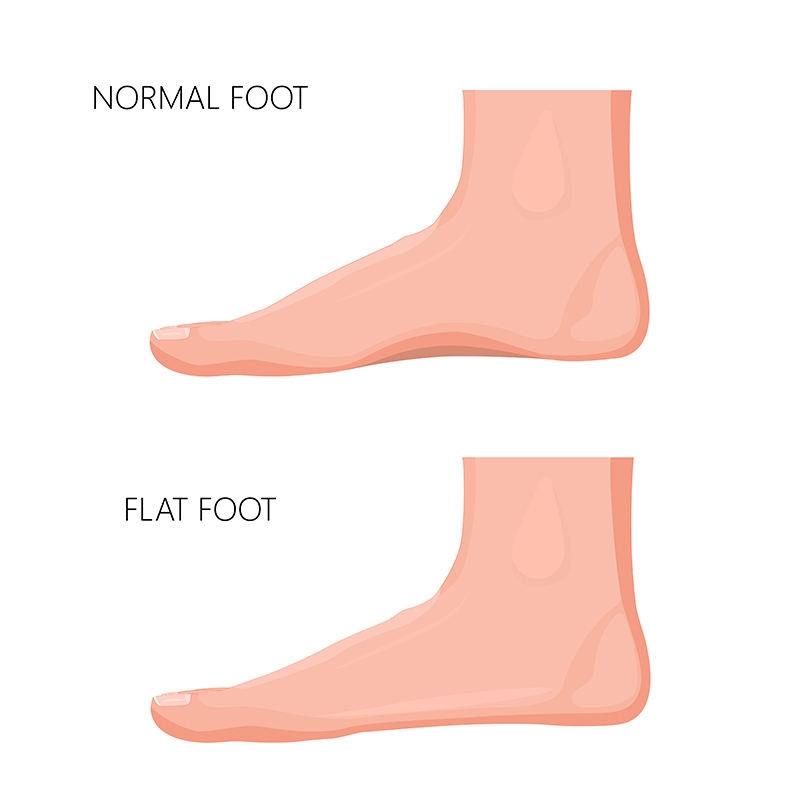Flatfoot is a foot deformity condition associated with collapse or absence of the foot arch that supports the weight of the body in the erect posture with the least weight. Flatfoot can affect both adults and children. Due to a wide variety of presenting symptoms, some patients might have no signs associated with flatfoot while some people may experience foot pain, particularly in the heel or arch area. Pain usually worsens with activity. Swelling along the inside of the ankle can also develop, resulting in impaired function of foot and ankle that can potentially lead to foot and ankle deformity.
Types of flatfoot
There are two main types of flatfoot which are:
- Congenital flatfoot: There are two general types of congenital flatfoot: flexible flatfoot and rigid flatfoot.
- Flexible flatfoot: Flexible flatfoot is often found in children. In flexible flatfoot, the foot has a normal arch at rest (not standing or walking), but it disappears once in contact with the ground while bearing weight. Flexible flatfoot in children is caused by lax ligaments, excess tissues in the foot or fat pad on the sole, resulting in a flattened arch while bone and joint abnormalities in the foot are not detected. Flexible flatfoot sometimes spontaneously resolves when the children grow up without any given treatment.
- Rigid flatfoot: Rigid flatfoot or true flatfoot develops due to congenital bone or joint deformities in the foot, resulting in limited range of motion, impaired mobility and weight bearing. The complete absence of arch in the foot often causes foot pain, particularly in the heel or arch area.
- Adult acquired flatfoot:
In adults, foot arch can also fall over time. Years of wear and tear can substantially weaken the tendon that runs along the inside of the ankle and supports the arch. A number of causes contribute to adult acquired flatfoot, such as:- Tendon dysfunction and degeneration: Damages to the tendon that supports the arch e.g. inflamed or torn tendon can lead to collapsed arch.
- Inflammatory arthritis: Rheumatoid arthritis can cause a painful flatfoot which does not only attack the cartilage in the joints, but also the ligaments that support the foot.
- Other causes e.g. muscle imbalance, conditions or injuries to the ligaments in the foot that cause the joints to fall out of alignment.
Signs and symptoms of flatfoot
During an early phase of flatfoot, most patients manifest no associated signs or symptoms. However, some patients with flatfoot may experience foot pain, particularly in the heel or arch area after walking or standing for a long time. Swelling in the sole and inside the ankle can also develop when the condition severely progresses without appropriate treatments. Warning symptoms of flatfoot that medical attention must be sought include:
- Foot pain that may be present in the inside arch or heel despite of wearing comfortable or healthy footwear.
- Inner heel swelling or swelling on the inside of the ankle or inflamed ligaments/tendons around the ankle.
- Balance impairment or difficulty walking, tiptoeing and climbing stairs.
- Ability to wear usual shoes that were worn in the past. Flattened arch becomes clearer to notice.
- Foot numbness, toe fatigue or noticeable deformities.

Diagnosis of flatfoot
Self-assessment of flatfoot can be simply conducted by getting the feet wet, standing on a flat surface where footprints can be shown e.g. concrete walkway, then stepping away and looking at the footprints. If complete imprints of the bottom of the feet on the surface can be noticed, it is likely to have flatfoot. If flatfoot is suspected along with mentioned symptoms, medical attention from orthopedic surgeon highly specialized in foot and ankle must be provided. Physical examinations include source of pain identification, foot and ankle alignment assessment as well as strength evaluation of surrounding ligaments/tendons. Additional investigations usually involve imaging tests using X-ray and CT scan. In case that detailed images of both hard and soft tissues are required, MRI scan might be additionally considered. Nevertheless, to avoid unnecessary investigations, diagnostic tests required for making a confirmative diagnosis primarily hinge upon physical examination results that might vary among individuals.
Treatment of flatfoot
If flatfoot becomes painful, non-surgical treatments are typically considered the first treatment option. Depending on causes and severity of flatfoot, these conservative treatments include arch supports (orthotic devices), supportive shoes, stretching exercises especially Achilles tendon and physical therapy such as ultrasound or laser devices. In addition, to relieve pain and mitigate inflammations, painkiller medicines can be taken as prescribed.
In case that flatfoot progresses and patients do not respond to given conservative treatments, surgical approach aiming for bone realignment and strengthening tendon that supports foot arch might be further considered. The surgical purposes are to restore patient’s range of motion, enhance normal mobility and return to daily life or activity as quick as possible.